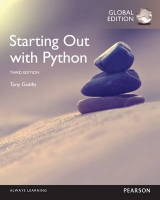
Starting Out with Python: Pearson New International Edition
Pearson Education Limited (Verlag)
978-1-292-02591-9 (ISBN)
- Titel erscheint in neuer Auflage
- Artikel merken
Preface xi
Chapter 1 Introduction to Computers and Programming 1
1.1 Introduction 1
1.2 Hardware and Software 2
1.3 How Computers Store Data 8
1.4 How a Program Works 13
1.5 Using Python 20
Chapter 2 Input, Processing, and Output 31
2.1 Designing a Program 31
2.2 Input, Processing, and Output 35
2.3 Displaying Output with the print Function 36
2.4 Comments 39
2.5 Variables 40
2.6 Reading Input from the Keyboard 49
2.7 Performing Calculations 53
2.8 More About Data Output 65
Chapter 3 Simple Functions 81
3.1 Introduction to Functions 81
3.2 Defining and Calling a Function 83
3.3 Designing a Program to Use Functions 89
3.4 Local Variables 95
3.5 Passing Arguments to Functions 97
3.6 Global Variables and Global Constants 107
Chapter 4 Decision Structures and Boolean Logic 117
4.1 The if Statement 117
4.2 The if-else Statement 125
4.3 Comparing Strings 130
4.4 Nested Decision Structures and the if-elif-else Statement 134
4.5 Logical Operators 142
4.6 Boolean Variables 149
Chapter 5 Repetition Structures 157
5.1 Introduction to Repetition Structures 157
5.2 The while Loop: a Condition-Controlled Loop 158
5.3 The for Loop: a Count-Controlled Loop 167
5.4 Calculating a Running Total 179
5.5 Sentinels 182
5.6 Input Validation Loops 185
5.7 Nested Loops 190
Chapter 6 Value-Returning Functions and Modules 203
6.1 Introduction to Value-Returning Functions: Generating Random Numbers 203
6.2 Writing Your Own Value-Returning Functions 214
6.3 The math Module 225
6.4 Storing Functions in Modules 228
Chapter 7 Files and Exceptions 239
7.1 Introduction to File Input and Output 239
7.2 Using Loops to Process Files 256
7.3 Processing Records 263
7.4 Exceptions 276
Chapter 8 Lists and Tuples 295
8.1 Sequences 295
8.2 Introduction to Lists 295
8.3 List Slicing 303
8.4 Finding Items in Lists with the in Operator 306
8.5 List Methods and Useful Built-in Functions 307
8.6 Copying Lists 314
8.7 Processing Lists 316
8.8 Two-Dimensional Lists 328
8.9 Tuples 332
Chapter 9 More About Strings 341
9.1 Basic String Operations 341
9.2 String Slicing 349
9.3 Testing, Searching, and Manipulating Strings 353
Chapter 10 Dictionaries and Sets 371
10.1 Dictionaries 371
10.2 Sets 394
10.3 Serializing Objects 406
Chapter 11 Classes and Object-Oriented Programming 421
11.1 Procedural and Object-Oriented Programming 421
11.2 Classes 425
11.3 Working with Instances 442
11.4 Techniques for Designing Classes 464
Chapter 12 Inheritance 483
12.1 Introduction to Inheritance 483
12.2 Polymorphism 498
Chapter 13 Recursion 509
13.1 Introduction to Recursion 509
13.2 Problem Solving with Recursion 512
13.3 Examples of Recursive Algorithms 516
Chapter 14 GUI Programming 529
14.1 Graphical User Interfaces 529
14.2 Using the tkinter Module 531
14.3 Display Text with Label Widgets 534
14.4 Organizing Widgets with Frames 537
14.5 Button Widgets and Info Dialog Boxes 540
14.6 Getting Input with the Entry Widget 543
14.7 Using Labels as Output Fields 546
14.8 Radio Buttons and Check Buttons 554
Appendix C The ASCII Character Set 577
Appendix D Answers to Checkpoints 579
Index
595
| Verlagsort | Harlow |
|---|---|
| Sprache | englisch |
| Maße | 219 x 276 mm |
| Gewicht | 1322 g |
| Themenwelt | Mathematik / Informatik ► Informatik ► Web / Internet |
| ISBN-10 | 1-292-02591-3 / 1292025913 |
| ISBN-13 | 978-1-292-02591-9 / 9781292025919 |
| Zustand | Neuware |
| Informationen gemäß Produktsicherheitsverordnung (GPSR) | |
| Haben Sie eine Frage zum Produkt? |
aus dem Bereich



